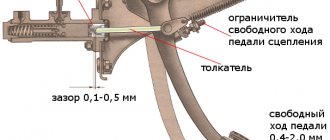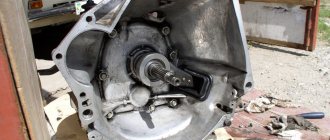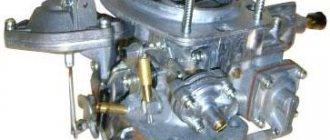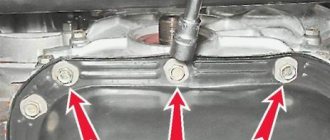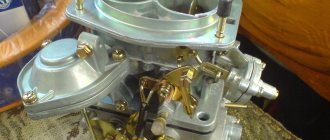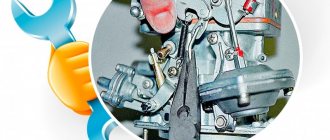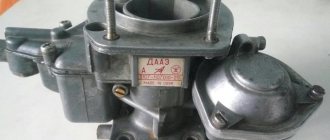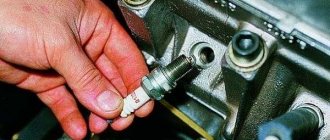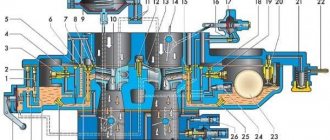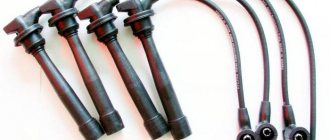Correct adjustment of the carburetor ensures normal operation of the power unit and significantly reduces fuel consumption.
In order to correctly adjust the quality of the mixture and fuel supply, you need to have a good understanding of how the power system works. Unfortunately, there are very few qualified carburetor specialists, so you have to master this procedure yourself. To do this, first of all, you should have a basic understanding of its structure. Knowing the principle of operation and what the quality of the fuel mixture depends on, you can make adjustments without the involvement of specialists. In this article we will look at how to adjust a VAZ carburetor with your own hands.
Carburetor structure VAZ 2107, VAZ 2105, VAZ 2104, Lada Zhiguli, Classic
Diagram of the main dosing system of the carburetor VAZ 2104, VAZ 2105, VAZ 2107 and econostat (the econostat spray is located in the second chamber of the carburetor. In the diagram it is conventionally shown in the first chamber): 1 - emulsion jet of the econostat; 2 — emulsion channel of the econostat; 3 — air jet of the main dosing system; 4 — econostat air jet; 5 — econostat fuel jet; 6 — needle valve; 7 — float axis; 8 — locking needle ball; 9 — float; 10 - float chamber; 11 — main fuel jet; 12 - emulsion well; 13 - emulsion tube; 14 — axis of the throttle valve of the first chamber; 15 — spool groove; 16 — spool; 17 — large diffuser; 18 — small diffuser; 19 – sprayer
Diagram of the carburetor idle system for VAZ 2104, VAZ 2105, VAZ 2107: 1 - throttle body; 2 — throttle valve of the first chamber; 3 - holes for transition modes; 4 - adjustable hole; 5 — air supply channel; 6 – economizer needle; 7 — forced idle economizer housing; 8 — economizer cover; 9 — hose connecting the economizer to the pneumatic valve; 10 — adjusting screw for the amount of mixture; 11 — adjusting screw for the composition (quality) of the mixture; 12 — emulsion channel of the idle system; 13 — carburetor body cover; 14 — air damper; 15 — air jet of the idle system; 16 — fuel jet of the idle system; 17 — fuel channel of the idle system; 18 - emulsion well; 19 — pneumatic valve; 20 - hose going to the inlet pipe
Diagram of the drive of the throttle valves of the Lada classic carburetor: 1 - pneumatic drive nozzle located in the diffuser of the first chamber; 2 — throttle valve drive lever; 3 - lever rigidly connected to the axis of the throttle valve of the first chamber; 4 - lever limiting the opening of the throttle valve of the second chamber; 5 — pneumatic drive jet located in the diffuser of the second chamber; 6 - lever connected to lever 9 through a spring; 7 — axis of the throttle valve of the second chamber; 8 — pneumatic drive rod; 9 — throttle control lever of the second chamber; 10 — channel for supplying vacuum to the pneumatic drive; 11 — rod bushing; 12 — pneumatic drive of the throttle valve of the second chamber
Diagram of the carburetor starting device for VAZ 2104, VAZ 2105, VAZ 2107: 1 - choke control lever; 2 – air damper; 3 — air pipe of the first chamber; 4 - traction; 5 — starting rod; 6 - diaphragm; 7 - adjusting screw; 8 - cavity communicating with the throttle space; 9 — telescopic rod; 10 — throttle valve drive lever; 11 - sector (antenna); 12 — axis of the throttle valve of the first chamber; 13 — lever on the axis of the throttle valve of the first chamber; 14 - lever connected to the air damper
Diagram of the accelerator pump of the carburetor VAZ 2104: 1 - screw valve; 2 - spray; 3 - fuel channel; 4 - bypass jet; 5 - float chamber; 6 — accelerator pump drive sector; 7 — drive lever; 8 — return spring; 9 — diaphragm cup; 10 — pump diaphragm; 11 — inlet ball valve; 12 — pump vapor chamber
The VAZ-2107 car is equipped with an emulsion-type carburetor, two-chamber, with a falling flow. It has a balanced float chamber, two main metering systems, an enrichment device (econostat) with a pneumatic drive, a crankcase gas suction system behind the throttle valve, a pipe for supplying vacuum to the vacuum ignition timing regulator of the ignition distributor, an autonomous idle system with an electronically controlled forced idle economizer by engine crankshaft rotation speed. The throttle valve of the first chamber is opened from the carburetor control pedal inside the car, and the throttle valve of the second chamber is opened from a pneumatic drive. The choke has a diaphragm trigger for starting a cold engine. A mechanically driven diaphragm-type accelerator pump supplies fuel to the first chamber. The carburetor is mounted on four studs in the intake manifold. Carburetor calibration data.
Adjusting the engine idle speed
NOTE: Blue bushings are installed at the factory, and red bushings are installed at service stations.
Screws for adjusting the idle speed system of the VAZ 2105 carburetor: 1 - mixture quantity screw; 2 - mixture quality screw
The idle speed adjustment of the VAZ 2104, VAZ 2105, and VAZ 2107 engines is carried out by screw 2, which determines the composition of the mixture, and screw 1, which controls the amount of the mixture. To ensure that the car owner does not violate the factory settings, restrictive plastic bushings are pressed onto the screws, allowing the screws to be turned only half a turn. If it is not possible to adjust the CO content in the exhaust gases with the bushings, then by unscrewing the screws, break the heads of the bushings, unscrew the screws, remove the bushings from them and screw the screws back into the carburetor. The idle speed adjustment of the VAZ 2107 is carried out on a warm engine (coolant temperature 90–95°C and oil temperature 75–90°C) with adjusted clearances in the gas distribution mechanism and with a correctly adjusted ignition timing.
Make adjustments in the following order:
— using screw 1, set the crankshaft rotation speed to 820–900 min-1 according to the stand’s tachometer, — using screw 2, achieve the concentration* of CO in the exhaust gases within 0.5–1.2% at this position of screw 1; — use screw 1 to restore the crankshaft speed to 820–900 min-1, — if necessary, use screw 2 to restore the CO concentration to 0.5–1.2%;
Determining the causes of fuel pump failure
To determine the cause of a fuel pump failure, you can use several operations related to checking its functionality without removing it from the car.
The fuel pump does not supply fuel to the vehicle systems:
- We check the presence of fuel in the gas tank. It is recommended to operate the car with at least half a tank and with the obligatory use of the entire set of filters that reduce the impact of small particles on fuel pump parts.
- We check the performance of the fuel filters and, if necessary, replace them with new ones.
- We blow out and clean the pipeline system, removing deposits of small particles.
Check fuel filters
The main reasons for fuel pump failure may be:
- Damage to the diaphragm with leaks.
- Loss of spring stiffness and performance.
- Valves clogged due to dirt accumulation.
- Loss of filter capacity due to the accumulation of contaminants.
- Violation of the tightness of the pump circuit with leakage of gasoline and oil.
- Failure to operate due to exhaustion of the pump components.
You can see how the DAAZ fuel pump works in the following diagram:
Internal structure of the fuel pump
DAAZ scheme
Next, you need to install the pusher in the working position; to do this, use the handle to turn the engine 1 revolution. The rod and eccentric will take a position that allows you to use manual fuel pumping.
When pumping, a working pump pumps gasoline without air. If a mixture of gasoline and air appears in the system, it is necessary to remove the pump and repair it to eliminate defects. To repair the pump, you must purchase a repair kit, which includes all the necessary spare parts.
If a fuel system malfunction occurs, the smell of gasoline appears in the car interior; the cause may be damage to the fuel pump diaphragm or broken threads of the fasteners. It is also possible that fuel may leak due to improper installation of the fitting.
The diaphragm design consists of a rod, a plastic spacer and three blades. The upper petals ensure the supply of fuel to the engine, and the lower petal cuts off oil from the cylinder block, as well as from gasoline in the event of a diaphragm failure. A return spring works together with the diaphragm, which also fails, which interrupts the fuel supply through the system (in automatic and manual mode). In some cases, the drive “foot” rod may malfunction (due to displacement to the side), which contributes to the failure of the fuel pump.
Fuel pump device
Sometimes situations arise when the pump operates intermittently, which is usually due to spring failure.
If it is difficult to start the engine, a possible cause may be wear on the fuel pump valves. When using a vehicle for a long time, the valves wear out, which leads to startup failures. After stopping the engine due to loss of tightness, the valves allow fuel to pass through, and it flows into the gas tank, and in order to start the engine again, it takes much more time for the fuel pump to supply fuel to the carburetor.
When the valve plate wears out, the plate changes its position, causing the pump to stop working. To eliminate such a defect, the plates began to be equipped with a rod, which prevents its displacement and rotation.
Situations also arise when the valve lining flies off and gets between the valve and the “seat,” which leads to a failure of the fuel pump.
It is also necessary to take into account that domestic gasoline pumps use three membranes: two for supplying fuel and one for sealing. Currently, there is no shortage of spare parts for any VAZ model. The distribution network presents all types of spare parts necessary to repair a car, regardless of modification and year of production.
Nuances of the VAZ-2105 carburetor adjustment process
Experts immediately warn inexperienced car enthusiasts: if you don’t know where the carburetor is located in the car and what it consists of, then you shouldn’t even start adjusting. By incorrectly changing the parameters of the fuel system, the entire vehicle can be damaged. It is best to entrust this procedure to qualified auto mechanics from a service station.
So, to begin adjusting the carburetor of a certain vehicle model, you need to study its structure. Thus, the VAZ-2105 carburetor contains several important systems:
- dosing;
- starting and warming up the engine;
- maintaining an optimal level of fuel fluid;
- starting idle;
- econostat system;
- accelerator pump.
Three of all the listed systems are subject to standard adjustment:
- Starting and warming up the internal combustion engine (the starting device is configured).
- Maintaining the fuel fluid level (the float mechanism is adjusted).
- Idle speed (speed calibration is performed using a specific screw).
To set them up, it is absolutely not necessary to remove the carburetor device from the car.
What do we have after proper adjustment of the carburetor unit of the “six”?
Checking the adjustments of the fuel mixture preparation unit is the same important maintenance step as monitoring the condition of the car battery . An integrated approach to setting up the carburetor guarantees not only a comfortable mode of movement, but also a lot of useful points:
- An increase in power and a confident increase in speed.
- No failures in the operation of the internal combustion engine in the low and medium speed sector.
- Improved dynamic characteristics - the car picks up speed faster and accelerates in a short time.
- Optimal engine response, which is expressed in the responsiveness of the gas pedal.
The listed qualities make it possible to effectively use the combustible mixture, which is necessary both in urban traffic jams and on country roads. Therefore, proper adjustment of the carburetor unit will help the car gain speed in a timely manner and complete the planned maneuver.
The carburetor on any vehicle is one of the components of the fuel system of an internal combustion engine. It mixes air with fuel liquid, and this mixture is supplied to the cylinders of the internal combustion engine. As you can see, this automotive part plays a very important role in the functioning of the vehicle as a whole. Therefore, the carburetor must be adjusted periodically. You will learn how to do this correctly on a VAZ-2105 from this article.
The first stage is setting up the float mechanism of the VAZ-2105 carburetor
First of all, to adjust the carburetor float mechanism, the car should be allowed to idle. And only after that begin the adjustment procedure.
- The carburetor cover is removed.
- The current level of fuel fluid in the chamber of the float mechanism is checked (its digital indicator should ideally be 28 mm).
If the digital indicator of the fuel level in the float chamber corresponds to the norm, then nothing needs to be adjusted. Otherwise, you need to do the following:
- check the distance from the cover gasket and the float itself (this is done at the moment the needle valve ball comes into contact with it) - the norm is 6.5 mm (+- 0.25 mm);
- bend the tongue;
- check the maximum stroke of the valve needle - the norm is 8 mm;
- check the distance from the cover gasket to the maximum retracted float - the norm is 14 mm (+- 0.5 mm).
If the indicators do not meet standard standards, they can be adjusted using a bracket. If the optimal level of fuel fluid in the float chamber was not obtained after adjustment, the needle valve will have to be replaced.
What models are installed on VAZ 2106/2107 cars
All types of carburetor mechanisms equipped with the VAZ 2106/2107 are aimed at reducing fuel consumption and giving the car maximum dynamism. In addition, an important role is played by such an indicator as environmental friendliness. For a decade, AvtoVAZ engineers gave preference to the most environmentally friendly types of carburetors.
Carburetors of three different models were installed on modern VAZ 2106/2107, as well as on cars produced in previous years:
- Manufacturer: Dimitrovgrad Automobile Assembly Plant (or DAAZ). It should be noted that the company produced carburetors under license from Weber. Structurally, these devices were as simple as possible both in operation and in further maintenance. In addition, their main advantage was to provide excellent speed performance for cars of the sixth and seventh VAZ models. At the same time, DAAZ carburetors consume a very large amount of gasoline - from 10 to 14 liters per 100 kilometers.
- Manufacturer: DAAZ, modification “Ozone”. This is a more advanced version of the first type of DAAZ, which has high environmental performance. The device provides good acceleration characteristics and consumes less than 10 liters of fuel per 100 kilometers. However, the disadvantage of this model is that it comes with a second camera. In its operation, a pneumatic valve plays an important role, which, in case of contamination or poor-quality adjustment, can stop the carburetor from working.
- Manufacturer: DAAZ, modification 21053, which is produced under license from Solex. One of the most modern types of carburetors for equipping the VAZ 2106/2107. Maximum environmentally friendly and productive. It has a more complex design; the first in the DAAZ line is equipped with a reverse fuel supply system, which makes it as economical as possible. However, Solexes are demanding on the quality of gasoline - otherwise the fuel nozzles become clogged very quickly.
Modern VAZ 2107 models are equipped with this unit.
Common features in the design of carburetors for the VAZ Six and VAZ Seven
The carburetor mechanisms that are equipped with all VAZ 2106/2107 models throughout the entire production period of the car are two-chamber, that is, they have two internal combustion chambers. Structurally, all carburetors have three indivisible parts:
- at the top there is a cover of the device, which protects the mechanism from dirt, and fuel fittings;
- the middle part is a housing, inside which the chambers and diffusers themselves are located, transfers the air-fuel mixture to the engine;
- The float compartment and throttle valves are located in the lower part.
In the operation of DAAZ carburetors, small parts are of great importance - gaskets, jets, float, economizer or dampers. All elements of the system are interconnected and failures in one part will inevitably lead to failure of the entire device.
The DAAZ carburetor on the VAZ 2106/2107 works according to the following principle:
- Gasoline enters the float chamber through the inlet valve.
- The required fuel level is regulated by the needle of the forced idle economizer or power stroke economizer - in any case, fuel enters the chamber in a strictly defined proportion.
- Next, the fuel is sent to emulsion chamber No. 1 through nozzles.
- In the chamber (or VBC), gasoline is crushed into small parts and mixed with air.
- When the torque increases during acceleration, internal combustion chamber No. 2 may also be activated.
- After the formation of the air-fuel mixture, the pump directs it to the diffusers, and through them to the engine.
That is, the main task of the carburetor is to form the air-fuel mixture in a strictly adjusted proportion to ensure smooth operation of the engine.
The presence of many small elements ensures reliable operation
The second stage - we adjust the starting device of the VAZ-2105 carburetor
At this stage, in a garage environment, a car enthusiast can perform the following steps to configure the carburetor system that starts and warms up the engine:
- close the air damper (this is done using the thrust handle located in the car interior);
- check the location of the rod shank, which must be at the end of the groove of the carburetor rod to start the system;
- measure the gap level from the edge of the valve to the chamber wall (measurements are taken when the rod is recessed) - the norm is 5-5.5 mm.
If the digital indicators differ from the established standards, they are adjusted by rotating a special adjusting screw (it is located on the carburetor trigger).
Write a review
Your feedback:
Attention: HTML is not supported! Use plain text. Grade:
Grade:
Bad Good
Enter the code shown in the picture:
Question: Is this an original DAAZ carburetor, not a fake?
Answer: The carburetors are original.
Carburetors from other manufacturers are often mistaken for fakes: AT, LSA, Road Map, PEKAR
These manufacturers have their own markings and appearance.
We have no information about cases of counterfeit carburetors of the main models produced by OJSC DAAZ. There is no protection on the carburetors either. It is better to make the purchase in the presence of an experienced motorist, who will be able to determine by appearance that the product is counterfeit. Start your purchase by inspecting the carburetor packaging.
Boxes for packaging carburetors are universal, with designations of carburetors that can be packed in them. A mark is made against the designation of the carburetor actually packed in the box, usually in the form of a tick.
All distinctive features, markings, appearance, etc. You can watch the video review on the product page
Question: What color is the box?
Answer: Carburetors come in boxes from LADA Image JSC and OAT Group
Packaging design of JSC "LADA Image":
Packaging design "Group OAT":
Question: There is a version that the original DAAZ products are packaged only in a red and white box, and everything else is fake.
Answer: The official website already has answers to similar questions. You can also find tips and tricks on setting up carburetors there.
Answer:
Answer:
Answer:
1) Why increase the speed much higher than recommended by the car manual?
2) When changing the idle mode only due to one adjusting element, inevitably, the mixture composition will go beyond the optimal range and unstable speed will appear.
Answer:
Question: I have a SOLEKS 21053 carburetor, should the float chamber needle keep the fuel flow if the return line is plugged? Answer: The float and needle valve are capable of maintaining a constant fuel level up to a pressure of 0.45 kg/cm2.
Question: I bought a carburetor 21053-1107010-20 for a VAZ-21053, and there are three vacuum distributor fittings. Which of these fittings (upper, lower or middle) should it be connected to, and what are the two additional fittings for? Answer: The lower fitting is intended for connecting the vacuum ignition timing corrector on the distributor-distributor. The two upper fittings should be plugged, because they are designed to control the exhaust gas recirculation valve, which your vehicle does not have.
Question: I read most of the “questions and answers”, but did not find an answer to my question. Which jets need to be changed on Solex 21053-1107010-20 for a 1.2l engine?
Answer: For a 1.2 liter engine. You need a carburetor 21051-107010 (currently not produced due to lack of demand) with 23x23 diffusers. On the carburetor 21051-1107010-20, you should install the fuel jet GDS 1 chamber 102.5 or 105, if there are comments on your fuel consumption.
Question: I have several questions about carburetors. 1. When installing a 21053 carburetor on a classic, what kind of textolite gasket should be used, thin or thick, between the carb and the intake manifold, and what will result from an incorrect installation (now the thick one seems to be from 8, but in your FAK I saw a message that you need to install 4mm) . 2. I have an engine displacement of 1650, compression 13-14, is carburetor 21053 suitable? Or is it better to put Ozone? 3. I was interested in why the second chamber in carburetor 21053 is very lean? (110/165) no other has such depletion, what is this connected with and wouldn’t it be better to put at least 115/165? 4.How does the level in the float chamber affect the flow rate? If it is less, then the consumption is also less and vice versa? How to correctly set the floats, in the literature there is a template according to which the level is set and at the same time it is said that from the gasket to the floats when the ball is pressed there should be 2mm and this somewhat contradicts the template. Why am I asking all this, I just found out experimentally that the jets in the first chamber exactly correspond to the factory ones (107.5/145 (slightly leaner)), but I haven’t really picked up the 2nd chamber yet... the dynamics are generally satisfactory, but the fuel consumption is slightly increased, sometimes 15l/ 100 km in the city, maybe it’s worth putting Ozone on my volume?
Third stage - idle speed adjustment
This stage is no less important than the previous two. To do this, the internal combustion engine is pre-started and warmed up. Only after this can the idle speed be adjusted.
- The motor is brought out using rotational movements of the mixture quantity screw - the norm is 850 rpm:
- to increase the speed, you need to rotate the mixture quality screw (to the maximum level);
- to reduce the speed you need to rotate the quantity screw (to the desired level of 850).
- Tighten the quality screw as far as it will go (rotational movements are performed until the motor stops shaking).
- Unscrew the same screw in the opposite direction three turns.
Setting idle speed
The process involves two screws that set the quantity and quality of the mixture. For high-quality settings, having a gas analyzer will not hurt. Before adjusting the carburetor on a VAZ 2106, you need to know about the restrictive plastic bushings that are pressed onto the adjusting screws. These plugs do not allow you to violate the factory settings. If this factor prevents you from setting XX normally, then you should break them out with a slotted screwdriver.
Idle speed control technology:
- With the air damper open, set the crankshaft speed screw to 800-900 rpm.
- Rotate the quality screw to set the maximum engine speed.
- Using the quantity screw, set the speed on the tachometer to 950-1030 rpm.
- Use the quality screw to set the maximum speed again.
- Repeat these operations until the speed of 950-1030 rpm does not coincide with the maximum speed set using the quality screw.
- After the moment of coincidence, return the quality screw to the position where the engine speed was 800-900 rpm.
If you have a gas analyzer, use a quality screw to achieve a CO concentration in the exhaust gases of 0.5-1.2%. The final position of the screws must be secured with plastic sealant to prevent spontaneous unscrewing.
Expert advice
After completing the procedure for adjusting the VAZ-2105 carburetor device, experienced auto mechanics recommend paying attention to the following critical points:
- Valve location - is in the retracted position, with the idle speed jet touching the seat in the carburetor body.
- Lubricating the rubber seal with special motor oil.
- The location of the air damper intended for cold passage is in a vertical plane, while the suction handle is lowered.
- The condition of the solenoid valve - the presence of damage and malfunctions is checked as follows:
- turn on the ignition;
- remove and put the connector on the valve;
- listen to the sounds coming from the solenoid valve.
If clicks are heard during the inspection process, the part is in full working order.
Oil type
We looked at what kind of oil to pour into a VAZ 2110 in winter based on such a parameter as viscosity.
But the type of lubricant should also be taken into account. There are three in total:
- Mineral;
- Synthetic;
- Semi-synthetic;
Mineral oil for winter VAZ-2109 is the worst option. Such a lubricant made by processing petroleum products is characterized by insufficiently good performance indicators, especially low-temperature viscosity. That is, its thickening threshold is much higher than that of other types of oil. But here it is worth noting that such oil for use as a lubricant is practically never found. But it is often used as a basis for flushing liquids.
Synthetic oil is one of the most optimal options for power plants of modern cars. It is obtained by synthesis, during which certain parameters of the lubricant are set, including viscosity. Therefore, when deciding which oil to pour into a VAZ-2114 in winter, preference should be given to synthetic oil.
It is these two criteria - viscosity and type that should be taken into account when determining which oil to fill in the VAZ-2115 or any other model for the winter.
Naturally, you should pay attention to the manufacturer. You should not buy lubricant from dubious places of sale or from little-known manufacturers. When choosing oil, it is better not to skimp.
When choosing oil, it is better not to skimp.
Adjusting the idle speed of a car engine with carburetors 2105, 2107 Ozone
Adjusting the idle speed of carburetors 2105, 2107 Ozone and their modifications is one of the most frequently performed operations in carburetor maintenance. As a result, it is necessary to achieve stable engine operation at a crankshaft speed of 850-900 rpm, as well as to normalize the content of CO and CH in the exhaust gases.
Tools required for adjusting XX speed
— tachometer (you can use the one built into the instrument panel) — slotted screwdriver (3 mm) If you don’t have a tachometer, you can adjust the idle speed by ear. But for this you must have at least some experience in car repair, since it is necessary to distinguish when the speed is normal and when it is increased or decreased.
Preparatory work
Before making adjustments, you must first make sure that the ignition timing is set correctly. The distributor cover, breaker contacts, armored wire and spark plugs are in good condition.
If the carburetor is after disassembly and reassembly or you simply need to set the initial value of the adjustment screws, then first tighten them completely, and then turn out the “quality” screw by 2-3 turns, and the “quantity” screw by 3-4.
— Warm up the engine to operating temperature (85-95 ). — With the engine stopped, connect the tachometer and start it again.
procedure for connecting an autotester (tachometer)
Adjusting the idle speed of an engine with a carburetor 2105, 2107 Ozone We carry out the adjustment in four stages.
1. Turn the “quality” screw and set the maximum idle speed.
Rotate the screw counterclockwise.
turn the “quality” screw of the fuel mixture of the carburetor 2105, 2107 Ozone counterclockwise, thereby increasing the supply of gasoline to the fuel-air mixture
2. Use the “quantity” screw to set an even higher rotation speed. For example, 80 rpm more. Rotate the screw counterclockwise.
rotate the “amount” screw of the fuel mixture counterclockwise, increasing the total amount of fuel mixture entering the engine cylinders
3. We check with the “quality” screw whether these revolutions are the maximum for the given position of the “quantity” screw.
Simply rotating it back and forth.
We check by rotating the “quality” screw in different directions whether the set idle speed is maximum
If not, then we carry out the above adjustments again.
4. Keeping the position of the “quantity” screw of the fuel mixture unchanged, tighten the “quality” screw so much that the speed drops to 850-900 rpm.
Adjustment in this way is very simple, but at the same time convenient, since it does not require special equipment.
If, after such an adjustment, the content of CO and CH emissions does not correspond to the norm or the idle speed cannot be adjusted, then it is necessary to check:
— whether the fuel and air jets of the main dosing system are dirty; — whether the main fuel jets of the first and second chambers are reversed; — whether the fuel level in the float chamber is increased; — Is the needle valve working? - Is the fuel jet of the idle system clogged; — whether the holder of the fuel jet of the idle system or the solenoid valve has turned away; — whether the tubes have come off the electro-pneumatic valve; — whether the rubber o-ring on the fuel mixture “quality” screw is damaged.
— In some cases, it makes sense to modify the carburetor idle system. See “Modification of the idle system of Solex and Ozone carburetors.”
Five more articles on the site on adjusting and tuning carburetors 2105, 2107 Ozone
When is adjustment needed?
Adjusting the carburetor unit is no more difficult than adjusting the clutch drive on a VAZ 2107, since it only involves adjusting the jets. In some cases, they need to be cleaned of resins and other contaminants; the presence of contaminants is felt by power dips in the process of accelerating. Many car owners claim that Ozone carburetors are not a very good option and recommend replacing them with Solex.
However, the signs that the device has begun to prepare an enriched mixture and needs to be adjusted are the same for both types of units:
- Increased fuel consumption.
- Frequent overheating of the motor.
- Black smoke from the exhaust pipe and pops.
- Loss of power.
The preparation of a lean mixture is characterized by the following characteristics:
- Popping sounds in the carburetor.
- Loss of power.
- Engine overheating.
Of course, you don’t always need to immediately grab a screwdriver and turn the adjusting screws - perhaps it’s something else. For example, when the idle speed floats, air may leak through the intake manifold gasket, or there may be a breakdown of the brake booster diaphragm. But even the reasons listed are not all the options, so specific recipes for eliminating certain problems cannot be given. The issue should be addressed comprehensively, taking into account the connection between vehicle systems.
Adjusting the VAZ-2105 carburetor - how is it done?
The process of adjusting the VAZ-2105 carburetor is a simple task that can be completed by any car owner who knows the structure and the sequence of necessary operations. The principle of operation of a carburetor is to create a fuel-air mixture by mixing gasoline with oxygen and then feeding it into the combustion chamber. In this article we will get acquainted with the design, features and advantages, and also take a detailed look at how to adjust this unit with your own hands.
What is a carburetor
The carburetor is installed in the center of the engine under the hood of the “seven” car. To clean the air, an air filter is placed on top of it. Air intake occurs through the front grille, as well as additional hood grilles.
Domestic VAZ cars have carburetors called standard:
All of these types are very popular among car enthusiasts, they last a long time and rarely break down.
The principle of their operation is largely similar, it consists in creating a combustible mixture by mixing fuel with air, then subsequently distributing and uniformly supplying this substance one by one to the engine cylinders.
There are three main types of carburetors: float, needle, bubbler. The latter is very rare and is practically never used.
For clarity, we will analyze the design and functional characteristics of the most popular VAZ carburetor with a float produced.
Before you begin to study its design, you need to understand that the versions of these devices may have serious differences, and therefore are installed strictly on certain machines.
The main elements of the carburetor that perform the work of providing and distributing the combustible mixture are gasoline and air nozzles, a VTS sprayer, a diffuser, an emulsion tube, and a well. All of these products are placed in the main dosing chamber.
Stages of setting up a VAZ 2015 carburetor
Without knowing the design of the car and without any experience in repairing, disassembling or assembling the fuel system of a car, it is not recommended to make adjustments. Changing the settings incorrectly may worsen the problem or damage the device. If you are familiar with the design of your car's carburetor, adjusting it will not be difficult. Adjusting the 2105 carburetor can significantly improve vehicle efficiency, reduce fuel consumption and increase the performance of the power unit. These so-called performance upgrades do not have any detrimental effect on the device. On the contrary, they are a mandatory procedure that guarantees long, uninterrupted operation.
Screws for adjusting the idle speed system of the VAZ 2105 carburetor: 1 - mixture quantity screw; 2 - mixture quality screw
Crankshaft speed calibration . The first thing to do is change the speed to 750-800 units per minute. To perform this procedure, a quantity adjustment screw is provided. It must be screwed all the way, and then unscrewed three times in the opposite direction.
Change in CO2 content . We regulate the amount of carbon dioxide in the exhaust using the quality screw. To do this, you need to screw the screw in until it stops, and then unscrew it back 4-5 turns. This will increase the concentration of fuel and richen the mixture.
Warming up the engine is a mandatory procedure, without which you cannot proceed to the next stages of work.
Speed adjustment . Using the quantity screw, we adjust the idle speed. It is necessary to achieve stable operation of the motor at 750-800 rpm. Gradually tightening the quality screw. During this process, the speed should increase slightly and then decrease, causing the engine to run erratically. After unstable operation of the power unit begins, we begin to screw the screw back in until the operation of the motor stabilizes.
Setting XX . Finally, you need to calibrate the idle speed using the appropriate screw to 800-900 units.
After completing all stages of adjustment and achieving the required parameters, you need to test the carburetor. With the engine running, sharply press the accelerator pedal and release it. If adjusted correctly, the crankshaft speed will temporarily increase. If the engine stalls, increase the speed using the appropriate adjusting screw. Check the operation of the motor at full load by turning on the stove, lights, etc.
Diagnostics
The primary conclusion whether the fuel pump is working or not can be assessed by ear when the ignition is turned on. If you can’t hear a quiet buzzing sound from behind, then you need to check the voltage supply to the gas tank block and later draw a conclusion about its malfunction.
Add to the group on VK https://vk.com/autovaz2107 Donation to pay for the web: WEBMONEY- R394885703159 YANDEX.
You can check the serviceability of the fuel pump using the MTL-2 pressure gauge; this is the most correct way. You can somewhat roughly estimate the pressure using air pressure gauges to check tire pressure. To do this, screw a rubber hose to the sensor and connect it to the fuel system.
The pressure of the VAZ 2107 injector fuel pump when the ignition is on should be 4.0 atmospheres, and when the ignition is running 2.8-3.2. In reality, the pump pressure is different and was slightly less, but this may be an error in the pressure gauge.
The carburetor pump is checked by setting the camshaft position by cranking the engine so as to ensure free movement of the pump foot. The hose is unscrewed from the carburetor or filter and the presence of fuel supply is determined by pressing the foot.
Video - How to set up a VAZ 2105 carburetor
Useful tips
- Valve position . It must be pushed in so that the idle jet touches its connector (seat) in the device body. To do this, it is recommended to lubricate the rubber seal with engine oil.
- Cold pass system air damper position, with the choke handle lowered, must be in a strictly vertical plane.
- When the quality adjustment screw is screwed in all the way, the engine should stall . If this does not happen, the reason may be incorrect adjustment of the VAZ-2105 carburetor. Using the appropriate bolts, you need to change the speed up.
- Vacuum in the tube between the carburetor and the ignition distributor . When the engine is idling, there should be no vacuum in the vacuum tube. The reason for its occurrence may be a tightly tightened locking screw of the throttle valve. Adjustment of this element is carried out using a locking screw. In the correct position, the damper does not jam in the diffuser and provides sufficient tightness. When 2-3 cm 3 of fuel is poured into the chamber, it should not noticeably leak through the valve. When you press the gas pedal, it moves smoothly without jerking. An identical method is used to test and adjust the damper on the second chamber, with the exception of the tube, which is only in the first chamber.
- Solenoid valve. In carburetors designed for engines with a displacement of 1500 cm 3 or more, in place of the holder of a conventional fuel jet there may be an electromagnetic valve with an XX jet. If it is included in the design of the device in question, it is necessary to check its functionality and ensure the integrity of the electromechanical element. With the ignition on, you need to remove and put the connector on the valve. The occurrence of clicks during these operations will indicate the serviceability of the part being tested.
- For the summer season, it is recommended to reduce the idle speed to 800-900 units, and in winter to increase it to 900-1000 rpm . This setting will improve the efficiency of the power unit taking into account climatic conditions.
Main parts
To perform its tasks, the carburetor
VAZ
2105 consists of the following mechanisms and systems:
See:
- Engine starting and warming up system.
- System for maintaining the required fuel level .
- System XX (idle);
- Econostat system.
- Acceleration pump.
- Main dosing system.
There are three systems that can be configured - they are first on the list. Adjusting the VAZ carburetor 2105
can be performed without removing the device from the machine.
How to adjust the carburetor on a UAZ. Due to the fact that the carburetors of the fifth and seventh models are identical in structure and differ only in the diameters of the holes of the air and fuel jets, the carburetor for the VAZ 2107 can be adjusted using the same method.
Adjustment instructions
To set up a cleaned and functional carburetor, you should prepare the following tool:
- short flat screwdrivers with narrow and wide slots;
- open-end wrench size 10 mm;
- the same, size 8 mm;
- narrow pliers.
The primary adjustment consists of adjusting the trigger cable and the gas pedal linkage. The latter is easily adjusted: the plastic tip is positioned opposite the hinge on the carburetor axis by twisting it along the thread. Fixation is carried out with a nut for a 10 mm wrench size.
The cable housing is attached with the air damper fully open.
The choke cable is adjusted as follows:
- Push the lever in the cabin all the way, set the air damper in a vertical position.
- Pass the cable through the eye of the cover and insert the end into the hole in the latch.
- Hold the barrel with pliers and tighten the bolt with a wrench.
- By moving the choke lever, make sure that the damper opens and closes completely.
The next step is to check the opening of the secondary chamber throttle. The stroke of the membrane and the rod should be enough for the damper to open 90°, otherwise unscrew the nut on the rod and adjust its length.
To shorten or lengthen the drive rod, you need to loosen the fixing nut
The support screw heads are fixed at the factory using special paint
The accelerator pump does not require additional adjustment. Make sure that the lever wheel is adjacent to the rotating sector, and the end is adjacent to the “heel” of the membrane. If you want to improve acceleration dynamics, replace the standard nozzle marked “40” with an enlarged one “50”.
The idle speed is adjusted in the following order:
- Turn out the quality screw by 3-3.5 turns, the quantity screw by 6-7 turns. Using the starter, start the engine. If the crankshaft speed is too high, reduce it with the quantity screw.
- Let the engine warm up, remove the choke and adjust the crankshaft speed to 900 rpm using the quantitative screw, using the tachometer as a guide.
- After 5 minutes, turn off the engine and check the condition of the spark plug electrodes. If there is no soot, the adjustment is complete.
- If black deposits appear on the spark plug, clean the electrodes, start the engine and tighten the quality screw 0.5-1 turn. Set the tachometer reading to 900 rpm using the second screw. Let the engine run and check the spark plugs again.
The best way to set up a DAAZ 2105 carburetor is to connect a gas analyzer to the exhaust pipe that measures the CO level. To achieve optimal gasoline consumption, you need to achieve readings of 0.7-1.2 at idle and 0.8-2 at 2000 rpm. Remember, the adjusting screws do not affect gasoline consumption at high crankshaft speeds. If the gas analyzer readings exceed 2 CO units, then the size of the fuel nozzle of the primary chamber should be reduced.
Ozone carburetors of the DAAZ 2105 model are considered relatively easy to repair and adjust. The main problem is the considerable age of these units, produced since the times of the USSR. Some copies have reached the required service life, as evidenced by large play in the throttle valve axles. Severely worn carburetors cannot be adjusted, so they have to be replaced entirely.
Adjusting the throttle drive
The figures below show the positions of the air damper with the choke recessed and extended.
Adjusting the air damper of the carburetor VAZ 2104, 2105, 2106 and 2107 is as follows:
- We recess the suction.
- Using a slotted screwdriver, unscrew the screw securing the rod (the spring sets it vertically).
- Tighten the screw.
- We check the movement of the air damper.
If you feel that the engine response is extremely low, and the acceleration dynamics leave much to be desired, then we recommend that you pay attention to adjusting the throttle valve drive, in other words, the “gas” drive. It is better to use a partner in this adjustment.
The tools we need are a screwdriver, a flashlight, a caliper and a 8mm wrench.
- Turn down the choke completely or close the air damper.
- Next, the partner must fully depress the gas pedal all the way to the floor. In this case, the air damper should open completely, as shown in the figure below. After releasing the gas pedal, the damper should close completely without any residual gaps.
- Using a caliper, we measure the length of the rod - it should be eight centimeters. For traction, it is adjusted by rotating the tips, having previously unscrewed the lock nuts.
- We put the rod in place and re-check the degree of opening of the air damper using the gas pedal.
In this article, we described to you how to independently adjust the carburetor of a VAZ 2104, 2105, 2106, 2107. We hope that our article was useful to you.
If you don't take care of the drive, the car may stall. To do this, you will need a simple Phillips screwdriver and a 7 mm open-end wrench.
The positions of the damper are shown above with the “suction” extended and recessed.
To adjust the drive, do the following:
- drown the “suction”;
- Unscrew the rod fixing screw with a screwdriver (the spring will push it out vertically)
- Tighten the screw;
- Check the valve stroke.
If this drive is incorrectly configured, the car's engine response drops and acceleration dynamics deteriorate. The setup is done with an assistant.
You will need the following tools: a screwdriver, an 8-mm open-end wrench, a flashlight, a ruler or a caliper.
- Turn down the “choke” (air damper drive) completely.
- Have your assistant press the gas pedal all the way to the floor. The throttle valve will open completely, as shown in the picture below, you can shine a flashlight into the first chamber. When you release the pedal, the damper should completely close the first chamber without any gaps. If there are gaps, then proceed to the next step.
- Next, we measure the length of the rod with a caliper; it should be exactly 8 cm. To adjust the length of the rod to the required size, rotate the tips by unscrewing the lock nuts.
After all these operations have been completed, put the rod in place and repeat the check. Nowadays, rods are made of low-quality plastic, which shrinks over time. Therefore, you need to check the operation of the traction after a week or two.
We looked at all the ways to adjust the carburetor yourself. We hope this article helped you, if you have any questions, ask them in the comments and we will definitely answer.
